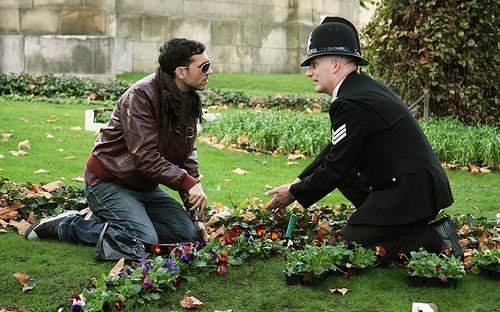‘I wanted to tell the story with the flower’: artist plants pansies at sites of homophobic abuse
- Paul Harfleet started the Pansy Project in 2005 after suffering homophobic abuse
- Originally starting in Manchester, Paul has planted pansies all over the world
- Paul has published a picture book aimed at children
Homophobia and transphobia have been around as long as the LGBTQ+ community itself.
With 64% of LGBTQ+ people experiencing anti-LGBTQ+ violence or abuse, many queer people are trying to reclaim their experience in various ways.
Paul Harfleet was subject to three separate instances of homophobic abuse in just one day in 2005.
After this he decided on a unique method of quiet resistance: planting pansies in places where the abuse occurred.

He said: “What I was interested in at the time was the way roadside memorials would change the way you read a street – you know that something happened if there is a roadside memorial.
“I thought planting a flower where I had these experiences was a similar thing.
“I wanted to tell the story with the flower, so the pansy was an obvious choice because it is also a term of abuse and I had been called a ‘f*ing pansy’.
“I don’t sign them in any way, it is just a flower in a location.
“The focus for me is the ritual of planting and the photograph. Then people go to my website, but obviously they aren’t going to necessarily know.
“When they do know and people see pansies in the street, they might then understand what I am doing.
“When I published my book, Pansy Boy, I had an article about my quest to find a publisher that was in the Guardian.
“My publisher read the article and remembered that he had seen a pansy that I had planted on the south bank with no signage and he’d understood somehow what that meant.

“You kind of understand if you’re in the know but the focus is on the website.”
The Pansy Project originally started with Paul planting the flowers at the sites of his own experiences, but soon after he started, he was travelling as far as Turkey and America for the project.
He adds: : “When I first started it in Manchester it wasn’t long before I was asked.
“It is usually in the context of a festival. I don’t just plant willy nilly, I have some sort of context, because for me planting is about community, so I require community support, often through a festival.
“I have worked with homotopia festival in Liverpool where I met with communities and planted pansies en masse.
“Often, I would do a planting tour. Last year I did that in Bristol which was part of an exhibition with M Shed and it’s about having a sort of structure around the project, so I can reach out to the community and find the locations through research and engagement.
“Planting the pansies with the community is a positive and political response to hate crime.

“It’s in the context of exhibitions and festivals so the network sort of grows in that way, over the years I have been asked to go to many queer festivals, such as homotopia and outburst in Belfast.
“When I launched the book, that took it in different directions because it is aimed at younger people, so I went to schools, read the book and planted pansies.
“Then I was a subject of a documentary in France that enabled me to take the film to festivals around Europe.”
Since starting the project, Paul found out why pansy has been used as a homophobic slur.
He said: “It is named after the french word penser, which is ‘to think’.
“In France they use it like an ‘I wish you were here’, they have an illustration of a pansy on a postcard, but it means I am thinking of you, like thoughtful.
“Then when it came over to England it became associated with thoughtful people, or thoughtful men which is a negative thing to be if you are a man, according to heteronormative society.”
They might think about the pansy before they go down the road of self-hatred and internalised homophobia
He added: “Fundamentally, the aim is to raise awareness that hate crime happens and it’s to raise awareness of the fact that we still, to this day, have these sorts of issues going on, if not more.
“There has been a massive increase of hate crime this year, especially in London. I know that in Liverpool and Birmingham that there has been a real increase.”
Whilst the pansy project is not yet synonymous with fighting hate crime, Paul hopes that it can be a small gesture that people can think about after having their own experiences with homophobic or transphobic hatecrime.

He said: “The thing that is really strong is the idea.
“If anyone experiences any homophobic hate crime in the street and they know about the Pansy Project, they might think about the pansy before they go down the road of self-hatred and internalised homophobia.
“They might think ‘I must find a place to plant a pansy around here’. It’s almost having the idea of it in people’s mind is the piece of work, if you like.”


